 Yo! Yo! Yo! Word! The Associated Press are getting hip and launching a news service for da yoot. Wicked, innit?!
Yo! Yo! Yo! Word! The Associated Press are getting hip and launching a news service for da yoot. Wicked, innit?!
On Monday, the near-ancient (well, 157 years old) newswire is launching its “younger audience service,” offering articles and “experiences” in multimedia formats, with audio, video, blogs and audience-participation features aimed at capturing the easily-distracted attention spans of a younger audience.
The hope is that all these interactive baubles will help entice the 70 million 18-to-34-year-olds in the US into becoming the next generation of news consumers by drawing them to AP’s member sites.
Naturally, farms of flapping flipcharts and masses of mood boards were employed as creative types toiled over their double mochas to come up with a suitably street name for the service, eventually christening it “asap”.
Apparently, the deal is that you pronounce the name letter by letter to “evoke the wire service’s legendary speed”. So don’t go upsetting those delicate designers by calling it “A Sap”
AP are claiming that the service will be “provocative, smart, relevant and immediate”, delivering the latest in news, entertainment, lifestyles, money and gadgets, and sports on a daily basis.
 So far, more than 100 newspapers have signed up for asap, with the option to use the content for their online editions, print editions or both.
So far, more than 100 newspapers have signed up for asap, with the option to use the content for their online editions, print editions or both.
According to Ruth Gersh, project development manager for asap, none of the papers would be charging readers for asap’s content.
Although no specific charges have been publicly released, pricing for the service will depend on the circulation of the newspaper buying it.
Ted Anthony, the comparatively ancient 37-year-old editor of asap, said that original material will be included in the service, penned by a new staff of twenty mainly New York based journalists.
Giving an example of the sort of content that might be used, Anthony said that an AP reporter in Kazakhstan might file a news article for the wire but recount his journey in an audio clip for asap.
“We want to bring people closer to the news and closer to their world, and we do that by recognising that there are real people who are gathering the news; they aren’t simply automatic fact-gatherers,” commented Mr Anthony.
Learning from focus groups and prototypes that their target audience demands a sophisticated view of the world with a need to be engaged, the answer is, apparently, to use the word “you” more in their articles.
“We’re doing things the AP has never done, and we’re using the incredible global scope of this organisation to bring the most interesting stories in the world to people in entirely new ways,” said Anthony, spectacularly failing to fit in a single engaging “you” in his comment.
 It’s funny, laugh!
It’s funny, laugh! Ew… That’s not nice!
Ew… That’s not nice! Flogging a dead horse… Literally
Flogging a dead horse… Literally The Times have covered Richard Freudenstein, COO of BSkyB, speech at the RTS Cambridge Convention
The Times have covered Richard Freudenstein, COO of BSkyB, speech at the RTS Cambridge Convention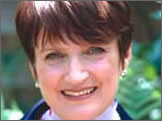 This regional order has been determined by a technical criteria determined by the broadcasters and Ofcom. The regional order will follow ITV regions. This ensures that the impact on ITV regional advertising markets is minimised.
This regional order has been determined by a technical criteria determined by the broadcasters and Ofcom. The regional order will follow ITV regions. This ensures that the impact on ITV regional advertising markets is minimised.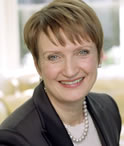 Comment – It is interesting that London will be switched in 2012. Same year as we host the Olympics.
Comment – It is interesting that London will be switched in 2012. Same year as we host the Olympics.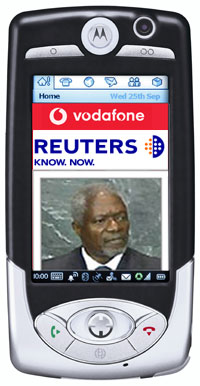 News agency Reuters has teamed up with Vodafone Live to offer a 3G streaming news video service for Vodafone customers in the UK.
News agency Reuters has teamed up with Vodafone Live to offer a 3G streaming news video service for Vodafone customers in the UK. Vodafone subscribers will also get technology, world, sports and entertainment news and be able to set up SMS breaking news alerts.
Vodafone subscribers will also get technology, world, sports and entertainment news and be able to set up SMS breaking news alerts. They may be a start up that no one’s heard of, but Truveo are making a big noise about their beta video search engine, claiming that it’s more up-to-date than either Yahoo or Google and produces higher quality results.
They may be a start up that no one’s heard of, but Truveo are making a big noise about their beta video search engine, claiming that it’s more up-to-date than either Yahoo or Google and produces higher quality results.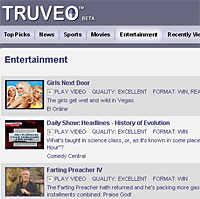 “For search to reach the next level and become truly ubiquitous, a fundamentally new approach is required to rapidly find and organize the vast amounts of television, movie and video content created every minute.” said the fabulously named Tim Tuttle, co-founder and CEO of Truveo.
“For search to reach the next level and become truly ubiquitous, a fundamentally new approach is required to rapidly find and organize the vast amounts of television, movie and video content created every minute.” said the fabulously named Tim Tuttle, co-founder and CEO of Truveo. The Economist is a publication that we regard highly. It’s not for nothing that they gained a strong reputation. Sadly a recent piece on the Digital Home let them down.
The Economist is a publication that we regard highly. It’s not for nothing that they gained a strong reputation. Sadly a recent piece on the Digital Home let them down. This was repeated with halls and halls of identikit stands. Remove the brand names and it would have been a challenge to tell them apart.
This was repeated with halls and halls of identikit stands. Remove the brand names and it would have been a challenge to tell them apart. Where The Economist got it wrong #2 – MSMedia Centre PCs are a failure
Where The Economist got it wrong #2 – MSMedia Centre PCs are a failure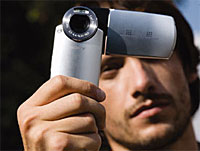 Sony’s boffins have announced the addition of a new hybrid camcorder/digital still camera to their Cyber-shot range.
Sony’s boffins have announced the addition of a new hybrid camcorder/digital still camera to their Cyber-shot range. Designed to be used with one hand, the M2 features a slightly tilted lens axis which allows a more natural wrist position according to Sony.
Designed to be used with one hand, the M2 features a slightly tilted lens axis which allows a more natural wrist position according to Sony. This automatically records five seconds of video before the still picture is taken, adding three more seconds of movie footage afterwards.
This automatically records five seconds of video before the still picture is taken, adding three more seconds of movie footage afterwards. Those really wishing to inflict pain on their friends could insist on using the Slide Slow plus Movie function.
Those really wishing to inflict pain on their friends could insist on using the Slide Slow plus Movie function. Hoity toity makers of expensive electronics for the well-heeled, Bang & Olufsen, have invited Samsung to the table in a joint project to design a new mobile phone.
Hoity toity makers of expensive electronics for the well-heeled, Bang & Olufsen, have invited Samsung to the table in a joint project to design a new mobile phone. According to Sorensen, there will be just one phone at first with more models to follow.
According to Sorensen, there will be just one phone at first with more models to follow.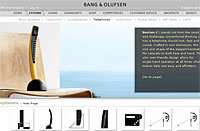 “We have positive expectations about this, but I know it is a niche product. The phone won’t appeal to all, but if only two percent of the market likes it, that’s good enough,” he added while tucking into a bowl of best Russian caviar.
“We have positive expectations about this, but I know it is a niche product. The phone won’t appeal to all, but if only two percent of the market likes it, that’s good enough,” he added while tucking into a bowl of best Russian caviar. Google’s virtual world domination plans continue afoot with the beta launch of their new blog search service, making the company the first major search engine to offer comprehensive blog and feed search capabilities.
Google’s virtual world domination plans continue afoot with the beta launch of their new blog search service, making the company the first major search engine to offer comprehensive blog and feed search capabilities. Google’s new service (sporting its trademark, no-frills interface) can be found at
Google’s new service (sporting its trademark, no-frills interface) can be found at  The Blogger version comes with a branded interface with an extra “use search options” link giving access to most common search advanced options, like searching in specific posts, entire blogs or specifying a date range to search within.
The Blogger version comes with a branded interface with an extra “use search options” link giving access to most common search advanced options, like searching in specific posts, entire blogs or specifying a date range to search within.